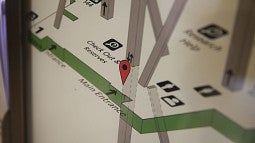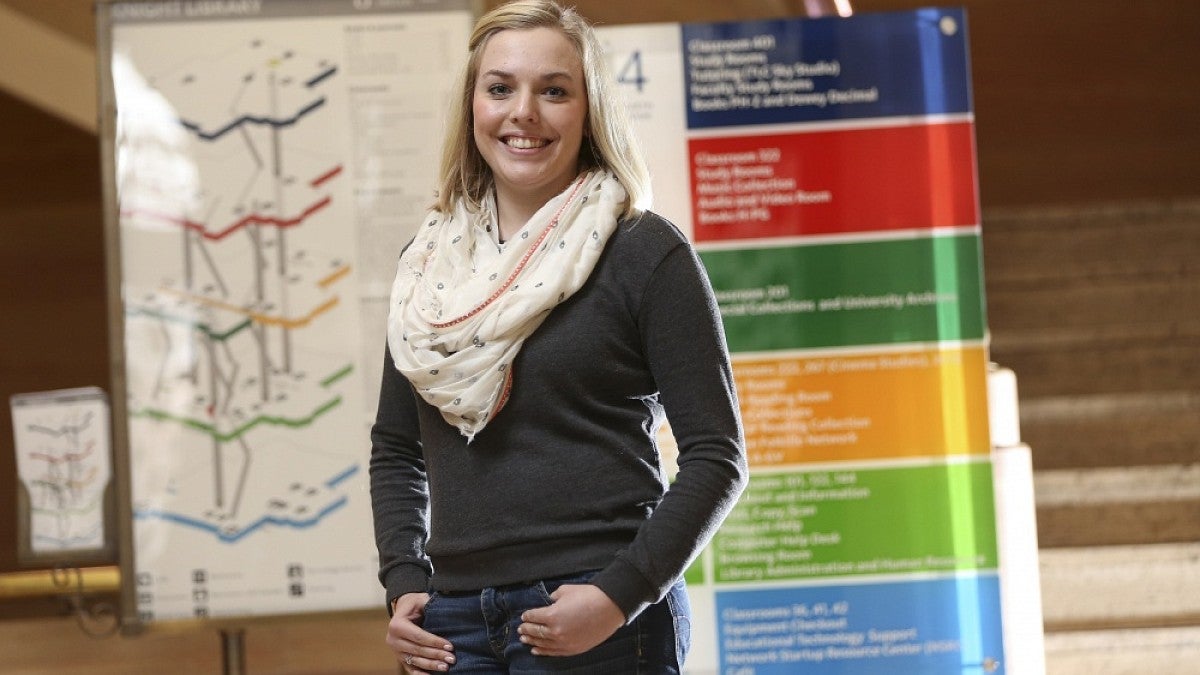Big, intimidating and overwhelming.
Those are the three words University of Oregon students used most to describe their first impression of the Knight Library on campus, according to research conducted by the library’s Wayfinding Task Force. The group was charged with making recommendations for and creating a plan for improved ease of navigation throughout the building.

The research — conducted in winter term 2015 — generated preliminary data on students’ experiences navigating through the historic building.
After finding that the building was indeed one of the most difficult to maneuver on campus, the library is now in the process of revamping its wayfinding system (floor maps, directories, find-it-fast maps, service identification signs and the like) with the help of undergraduate student Jenna Mogstad, a fourth-year interior architecture major in the UO School of Architecture and Allied Arts.
Since she began working at the library in mid-2015, Mogstad has been integral in the design and management process, helping implement a brand-new directory system that includes more than 100 new-and-improved signs and maps.
“Once we had our findings and discovered where the design weaknesses were, we were able to bring a design student in who created a new system that we could build,” said Kirstin Hierholzer, director of user experience at the library. “We’ve been able to come at it from all directions, but especially from the user’s perspective.”
Various elevator and bathroom signs have made the transition to gender-neutral icons and general signage has been more widely distributed throughout the building. Most important, the wayfinding system is now completely integrated and consistent throughout all four floors of the library.
“The whole wayfinding system is catered towards undergraduates and the public services they’re going to be accessing in the library,” Mogstad said. “It’s more of an at-a-glance system, with a new color scheme and updated icons that are consistent. It’s what we hope to become the new campus standard.”
Lesli Larson, director of library communications and marketing, noted that complete integration of the new wayfinding system was essential. In collaboration with local printing business Image King Signs and Tim Jordan of UO Marketing and Communications — in addition to Mogstad’s design know-how — the task force was able to create coherent signage, maps and other directories that were not only consistent in color and icons, but in their basic material as well.
“Jenna was able to use her skillset to build our maps and signage and helped us realize what works and what wouldn’t,” Larson said. “Having Jenna was in lieu of having an outside vendor do the planning and design. Her enthusiasm was just huge.”
One of the major problems with the previous wayfinding system was that it was not suited to adaptation and change. Having gone through several minor remodels in the past, many of the library’s rooms have undergone name changes and the layout of several spaces has been altered, especially on the top floors.
“We’re designing the system to be completely updateable,” Mogstad said. The signs and maps are “constructed in such a way that they can be updated and changed as time goes on — for example if a room goes nonpublic or if the name of a place changes — so we’re being proactive in that sense.”
Phase 1A of the project, which was the updates on wall directories, utility flag mounts, floor maps, find-it-fast maps and the exploded-view maps, has been completed. The second part of that phase — 1B — will be complete in the near future, including more elevator directories, continuous directional signs, website maps, Special Collections and University Archives signage, hanging signs, book stack signs and external building signage.
Beyond designing the new wayfinding system, Mogstad has been able to garner professional experience and add to her personal portfolio while still attending school, a rare opportunity for undergraduates. For both the library team and Mogstad, it was a match that proved extremely beneficial.
“She’s part of the team,” Hierholzer said. “She’s really taken a leadership role in many ways and has really been involved.”
“It’s been so helpful to get that real-life experience, as opposed to a school studio project where I would only get feedback from a professor, and now I get feedback from not only the library staff, but the entire campus community,” Mogstad said. “It’s been invaluable for me. I don’t know who you could say it’s benefitted more.”
— By Nathaniel Brown, Public Affairs Communications


